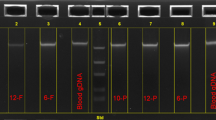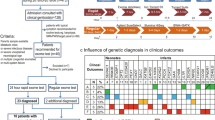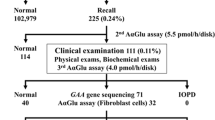Abstract
G6PD deficiency is the commonest enzyme deficiency found in humans. Current diagnostic methods lack sensitivity to detect all cases of G6PD deficiency. We evaluated the reverse dot blot flow-through hybridisation assay designed to detect simultaneously multiple known G6PD mutations in a group of Malaysian neonates. Archival DNA samples from 141 G6PD-deficient neonates were subjected to reverse dot blot flow-through hybridisation assay using the GenoArray Diagnostic Kit (Hybribio Limited, Hong Kong) and DNA sequencing. The method involved PCR amplification of 5 G6PD exons using biotinylated primers, hybridisation of amplicons to a membrane containing oligoprobes designed for G6PD mutations known to occur in the Malaysian population and colour detection by enzyme immunoassay. The assay detected 13 of the 14 G6PD mutations and genotyped 133 (94.3%) out of 141 (102 males, 39 females) cases. Among the 39 female G6PD-deficient neonates, there were 7 homozygous and 6 compound heterozygous cases. The commonest alleles were G6PD Viangchan 871G > A (21%) and G6PD Mahidol 487G > A(20%) followed by G6PD Mediterranean 563C > T, (14%), G6PD Vanua Lava 383T > C (12%), G6PD Canton 1376G > T (10%), G6PD Orissa 131C > G (6.3%) G6PD Coimbra 592C > T (5.6%) plus 6 other mutations. DNA sequencing of remaining cases revealed 6 cases of intron 11 nt 93C > T not previously reported in Malaysia and two novel mutations, one case each of nt 1361G > T and nt 1030G > A. We found the reverse dot blot assay easy to perform, rapid, accurate and reproducible, potentially becoming an improved diagnostic test for G6PD deficiency.
This is a preview of subscription content, access via your institution
Access options
Subscribe to this journal
Receive 12 print issues and online access
$259.00 per year
only $21.58 per issue
Buy this article
- Purchase on Springer Link
- Instant access to full article PDF
Prices may be subject to local taxes which are calculated during checkout


Similar content being viewed by others
Change history
08 May 2020
An amendment to this paper has been published and can be accessed via a link at the top of the paper.
Notes
One patient with an enzyme activity of 109.5% was excluded.
References
Cappellini MD, Fiorelli G. Glucose-6-phosphate dehydrogenase deficiency. Lancet. 2008;371:64–74. https://doi.org/10.1016/S0140-6736(08)60073-2.
Minucci A, Giardina B, Zuppi C, Capoluongo E. Glucose-6-phosphate dehydrogenase laboratory assay: how, when, and why? IUBMB Life. 2009;61:27–34. https://doi.org/10.1002/iub.137.
Nkhoma ET, Poole C, Vannappagari V, Hall SA, Beutler E. The global prevalence of glucose-6-phosphate dehydrogenase deficiency: a systematic review and meta-analysis. Blood Cells Mol Dis. 2009;42:267–78. https://doi.org/10.1016/j.bcmd.2008.12.005.
Howes RE, Piel FB, Patil AP, Nyangiri OA, Gething PW, Dewi M. et al. G6PD Deficiency prevalence and estimates of affected populations in malaria endemic countries: a geostatistical model-based map. von Seidlein L, editor. PLoS Med. 2012;9:e1001339. https://doi.org/10.1371/journal.pmed.1001339.
Ainoon O, Joyce J, Boo NY, Cheong SK, Zainal ZA, Hamidah NH. Glucose-6-phosphate dehydrogenase (G6PD) variants in Malaysian Chinese. Hum Mutat. 1999;14:352.
Ainoon O, Yu YH, Amir Muhriz AL, Boo NY, Cheong SK, Hamidah NH. Glucose-6-phosphate dehydrogenase (G6PD) variants in Malaysian Malays. Hum Mutat. 2003;21:101. https://doi.org/10.1002/humu.9103.
Wan ASL, Mat Daud S, Teh SH, Choo YM, and Kutty FM et al. Development group clinical practice guidelines management of neonatal jaundice. 2nd ed. Malaysia Health Technology Assessment Section (MaHTAS) Medical Development Division, Ministry of Health Malaysia. 2014.
World Health Organization. Glucose-6-phosphate dehydrogenase deficiency. Bull World Health Organ. 1989;67:601–11. http://www.pubmedcentral.nih.gov/articlerender.fcgi?artid=2491315&tool=pmcentrez&rendertype=abstract.
Ainoon O, Alawiyah A, Yu YH, Cheong SK, Hamidah NH, Boo NY. et al. Semiquantitative screening test for G6PD deficiency detects severe deficiency but misses a substantial proportion of partially-deficient females. Southeast Asian J Trop Med Public Health. 2003;34:405–14.
Reclos GJ, Hatzidakis CJ, Schulpis KH. Glucose-6-phosphate dehydrogenase deficiency neonatal screening: preliminary evidence that a high percentage of partially deficient female neonates are missed during routine screening. J Med Screen. 2000;7:46–51. https://doi.org/10.1136/jms.7.1.46
Azma RZ, Hidayati N, Farisah NR, Hamidah NH, Ainoon O. G6PD enzyme activity in normal term Malaysian neonates and adults using a OSMMR2000-D kit with Hb normalization. Southeast Asian J Trop Med Public Health. 2010;41:982–8. http://www.ncbi.nlm.nih.gov/pubmed/21073074. Accessed 11 Jan 2019
Hu R, Lin M, Ye J, Zheng BP, Jiang LX, Zhu JJ. et al. Molecular epidemiological investigation of G6PD deficiency by a gene chip among Chinese Hakka of southern Jiangxi province. Int J Clin Exp Pathol. 2015;8:15013–8.
Minucci A, Moradkhani K, Hwang MJ, Zuppi C, Giardina B, Capoluongo E. Glucose-6-phosphate dehydrogenase (G6PD) mutations database: review of the “old” and update of the new mutations. Blood Cells, Mol Dis. 2012;48:154–65. https://doi.org/10.1016/j.bcmd.2012.01.001.
Davidson RG, Nitowsky HM, Childs B. Demonstration of two populations of cells in the human female heterozygous for glucose-6-phosphate dehydrogenase variants. Proc Natl Acad Sci USA. 1963;50:481–5. https://doi.org/10.1073/pnas.50.3.481.
Wong F, Boo N, Othman A. Risk factors associated with unconjugated neonatal hyperbilirubinemia in Malaysian neonates. J Trop Pediatr. 2013;59:280–5. https://doi.org/10.1093/tropej/fmt023.
Wang J, Luo E, Hirai M, Arai M, Manand E, Isa, Z. et al. Nine different glucose-6-phosphate dehydrogenase (G6PD) variants in a Malaysian population with Malay, Chinese, Indian and Orang Asli (Aboriginal Malaysian) backgrounds. Acta Med Okayama. 2008;62:327–32.
Ren X, Du C, Lin Q. Studies on a G6PD polymorphic site, cDNA C1311T. Zhonghua Xue Ye Xue Za Zhi. 1999;20:197–9. http://www.ncbi.nlm.nih.gov/pubmed/11601228. Accessed 11 Jan 2019
Neonatal Jaundice Clinical Guideline Neonatal Jaundice. 2010. http://www.nice.org.uk/guidance/CG98. Accessed 11 Jan 2019.
Acknowledgements
This work was funded by Universiti Sains Islam Malaysia Short Term Research Grant PPP/USG -0216/FPSK/30/17716 as well as UKM Medical Centre Fundamental Grant (FF-2016-089) and (FF-2017-058).
Author information
Authors and Affiliations
Corresponding authors
Ethics declarations
Conflict of interest
The authors declare that they have no conflict of interest.
Additional information
Publisher’s note Springer Nature remains neutral with regard to jurisdictional claims in published maps and institutional affiliations.
Rights and permissions
About this article
Cite this article
Alina, M.F., Azma, R.Z., Norunaluwar, J. et al. Genotyping of Malaysian G6PD-deficient neonates by reverse dot blot flow-through hybridisation. J Hum Genet 65, 263–270 (2020). https://doi.org/10.1038/s10038-019-0700-7
Received:
Revised:
Accepted:
Published:
Issue Date:
DOI: https://doi.org/10.1038/s10038-019-0700-7



